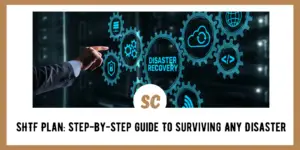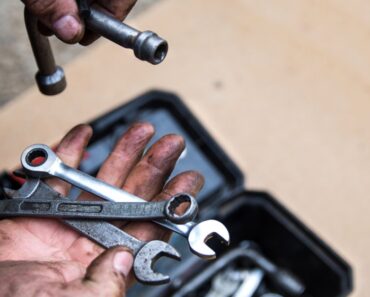When disaster strikes and the SHTF (sh*t hits the fan), the time for planning has passed, and you need to be ready to rock and roll. Buying stuff and putting together kits is easy, but having supplies doesn’t ensure your survival. A good emergency plan and survival skills will give you a huge headstart.
As Benjamin Franklin once said, “By failing to plan, you are planning to fail.”
But how do you have a plan for everything? Honestly, the answer is that you can’t.
However, you can plan ahead for a lot of events. By doing so and practicing your survival skills, you will be more ready for almost any SHTF situation occurring.
To help you be ready for almost any disaster, this article will be discussing SHTF events and how to plan for them. We will be going over:
- Potential SHTF scenarios and how to analyze your situation
- How to make and update SOPs (Standard Operating Procedures) so you always know what to do
- How to practice your plan and choose the right supplies to stock up on
What’s SHTF
SHTF stands for “poo hitting the fan,” but in adult terms. It’s a term used to describe a really bad situation. And by “really bad,” I mean a situation that – if you don’t act accordingly – your safety and survival are on the line.
There are small-scale disasters and large-scale disasters, but this term gets overused nowadays, and people have become too comfortable with it by using it for almost anything.
Let me give you an example. Getting a flat tire on the side of the road is an annoyance, frustrating, and inconvenient…but it’s not SHTF. On the other hand, I would consider a big tornado bearing down on your town SHTF.
Severe weather and natural disasters are typically smaller-scale and localized versus large-scale human disasters like war, but you still need to prepare for them.
Potential SHTF Scenarios: Nuclear and Biological Warfare, Etc.
There are a lot of situations one can prepare for. Smaller-scale disasters occurring on a more localized level include, but are not limited to:
- Large-scale natural disasters (i.e. hurricanes, wildfires)
- Regional conflict
- Biohazard or health outbreak
- The electrical grid going down
Here are some other possible SHTF events that I would consider large-scale SHTF scenarios:
- Nuclear or biological warfare (nuclear war and biological warfare is probably the single large-scale disaster most feared in our times)
- An electromagnetic pulse (EMP)
- Severe economic collapse
- International financial systems fail
- Large-scale natural disasters
- Significant asteroid impact
- Widespread infection of a disease or a pandemic
- Volcano or supervolcano eruption
- War
- Civil wars, unrest/social upheaval, and any other widespread problems
Small Scale Problems Can Lead to Large Scale SHTF Scenarios
Unfortunately, it is human nature to not always consider problems a problem until they are on our doorstep. At the time of this article, we here in the United States are witnessing how compounding small-scale disasters can become large-scale human disasters covering widespread regional areas.
Early in February of 2023, a train derailed in East Palestine, Ohio. Normally, a train derailment wouldn’t be considered a SHTF situation, and people several states away probably didn’t think much of it at first.
But several of the train cars were carrying hazardous materials, which were later set on fire in a controlled manner.
Compounding “small-scale disasters” like this widen the danger zone considerably, turning a relatively small SHTF situation, into a large-scale SHTF situation.
At the time of this article, we still haven’t seen the full effects of this small-scale compounding disaster.
SHTF Plan, Step-by-Step Process
1. Analyze Your Situation
The place to begin is by analyzing your situation. You can’t copy and paste another person’s SHTF plan into your life. Yes, some ideas and methods will transfer, but everyone’s situation and circumstances differ.
Now that we have become more globalized, the number of threats has increased to the individual. However, you need to recognize the dangers that are most likely to happen to you, or the ones you are most concerned about.
Once you have made that list, the next step is to prioritize those events. Here is an example:
I’m concerned about severe weather/natural disasters and an asteroid impact. Do asteroid impacts happen? Absolutely, but I have had to deal with severe weather and natural disasters a lot in my life, whereas asteroid impacts I have not.
This means I would prioritize my efforts to deal more with mother nature than I would a rock from space.
The next step is to find out what you need to do to handle the effects of those events on your list so that you can be ready and prepared.
Make SOPs
SOP stands for Standard Operating Procedure, and it’s just a fancy term for a detailed instructional guide for how to do something or what you should do in a certain scenario, like a SHTF situation.
For example, a general SOP for severe weather might be:
- Check batteries and recharge devices
- Check the water and food supply
- Check medical supplies
- Check on your shelter and make sure your supplies are in place.
Now apply the above principle to every single event on your list (SHTF plan), collect information, and be sure to put in as much detail as possible.
Update SOPs
A plan is similar to the gear you pack away in a bug-out bag (BOB). You can’t just pack a BOB, stick it in a closet for years, and expect everything to work when you need it. Things happen, and you need to check on your gear occasionally to ensure everything is still functional.
The same is true with your SOP or SHTF plan.
Things happen in life and your circumstances change which can affect your SHTF plan. Here is an example:
Let’s say my evacuation plan is to go to my best friend’s house who lives fifty miles away. One day my friend moves much further away, and I don’t update my plan. Everything about that plan has changed, and if something bad happens, then I’m going to have to plan while on the move.
Plan ahead as much as possible and keep your plans up to date.
Work The Plan
This is where most people fail.
They make an excellent SHTF plan and put it on a shelf, never putting it into practice.
SHTF planning requires simulations, which are the closest thing we have to the real deal, and by running them, we find a lot of valuable information. What looks good on paper doesn’t always work well in the real world.
Here’s an example:
Let’s say I pull out a map and create a route for a bug-out plan, but that’s all I do. There is a bunch of information within that plan that is left out. For instance:
- How long does it take me to load up my vehicle?
- What is the average drive time from point A to point B?
- Is traffic heavier at different times of the day?
- Are there a lot of traffic lights, stop signs, or intersections that could slow me down?
- Are there “bad” neighborhoods along the route?
- Are there bottlenecks like bridges?
- Are there resupply points along the route, i.e. gas stations, and grocery stores?
- What’s the terrain like if I have to abandon my vehicle and go on foot?
These are just a few examples of things that you will find out when you put your plans into practice, and they will all have an effect on you during SHTF events.
Wrong Place
Look, we can make excuses all day long for not taking action, but the solutions to problems are usually very simple. Not easy, but simple. One of the best ways to avoid a SHTF situation is to not be where the problem is.
If a massive hurricane is bearing down on your location, then leave.
If social upheaval is only getting worse in your area, then leave.
If you are out and about and you see violence unfolding or the potential for it, leave.
If the local authorities or the local leader in your region are making it unsafe and more difficult for you to live the way you want to, leave.
Realize It’s On You
If you think someone will always be there to help or that help is always just a call away, you will never be ready.
Once you realize you are your own first responder, things quickly become a whole lot more clear. You’ll understand that you should be knowledgeable about first aid techniques, how to defend yourself, and other survival skills. The responsibility of your survival is just that – yours.
Get Into Shape
The majority of us are in poor health, myself included. But to survive a disaster, you need to be strong – physically, mentally, emotionally, and spiritually.
How can you expect to survive an SHTF situation if you:
- Can’t walk a mile without becoming extremely winded
- Have no plan
- Don’t know how to focus
- Break down about every problem
- Don’t have a purpose or calling to draw from
One of the best pieces of advice I have ever heard is to work on yourself and get into shape so you are hard to kill.
War Games And Situational Awareness
This is similar to running simulations, but do them in your head when you are out and about. Ask yourself these questions:
- Where are the exits?
- Are there defensive tools within reach I can use?
- What will I do if that erratically driving vehicle ten cars ahead causes an accident?
- Why is that person acting the way they are?
By performing these exercises, you stay mentally alert and have an action plan ready for when something goes down. Always practice situational awareness.
Kits
It’s important to develop kits, some of which you can carry with you so that you are organized and prepared. Other than what you may have in your home, it’s a good idea to create an everyday carry (EDC), get home bag (GHB), first aid and trauma kit, and an “I’m never coming home” kit (I.N.C.H)
SHTF Plan Gear And Supplies
It’s impossible to be ready for every SHTF scenario at a moment’s notice – some situations call for specialized gear or supplies. However, there are basic items that carry over and are useful and needed in almost any type of emergency. Below is a brief list of items that will help you in almost any SHTF situation.
Medical
Get yourself a proper first aid kit and trauma kit and have them close to you at all times. On top of that, know how to use the items in the kit.
Water
Store as much potable water as possible, water filters, water purification methods, and water containers.
Food
Store a variety of different non-perishable foods with long shelf lives, create sustainable food sources (i.e. gardens, and livestock), and have the tools and knowledge to hunt and fish.
Fire Making Tools
Fire is one of mankind’s oldest and most powerful tools. It can be used for light, warmth, cooking, purifying water, and signaling for help, just to name a few examples. A simple lighter is one of the easiest tools to use and ferrocerium rods are great tools as well.
Knife and Multitool
A knife is one of the most versatile tools in a survival kit and when paired with a multitool and your survival skills, there won’t be much you can’t handle.
Flashlight
If you can’t see in the dark, the SHTF event you find yourself in is going to get a whole lot worse. A quality, pocket-sized flashlight will go a long way in keeping you safe and seeing the dangers ahead.
Emergency Whistle
An emergency whistle can be carried around the neck or even on a keychain, and it is a great way of signaling for help, even in rather noisy locations.
Wrap Up
The stark reality is that there are a lot of things in this world we and our loved ones need to be prepared for. I don’t say this so that you will live in fear, quite the opposite. When one domino falls, eventually resulting in a SHTF event, you won’t have to be fearful if you have properly planned.
Don’t get distracted by fad prepping or bad information and remember to cover the most likely and possible scenarios when SHTF planning. By doing so, you and your loved ones will be better prepared and ready for when the shit hits.
Thanks for reading, and stay prepared!







































